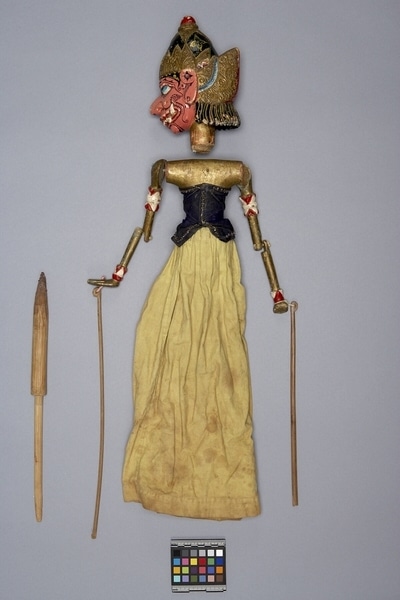Rod Puppet Item Number: Ib276 a-c from the MOA: University of British Columbia


Description
Painted wooden body (part a) of a female puppet with gold, black, red, blue and white headdress. Hair or fringe extending at neck. Pink face (part b) with black lined motif. Red mouth and white fangs and teeth. Blue eyes. Moveable gold coloured arms; red and white bands at wrists and biceps. Black cloth bodice edged with gold beads. Two red sequin rosettes at bosom. Soiled and patched yellow cotton skirt; single green pattern sewn with yellow thread attached at waist. Hand on left broken; piece missing. Arms articulate; one to right cannot be fully extended. Pointed controlling rod with rounded sides (part c).
History Of Use
Javanese puppetry as an art form probably developed by the 11th century. The three-dimensional wooden wayang golek puppets of western Java, which are to be distinguished from the earlier and more sacred wayang kulit shadow plays puppets or other forms, appeared during the 16th century. Originally the plays depicted Javanese mythology, but after the Indian conquest of Java the Hindu epics, Ramayana and Mahabharata, were incorporated into the cycles, which comprise about 200 plays. An individual or group hires a dalang (puppet-master) to celebrate important occasions. The performances often last all night and are generally presented in three acts, with vocal and instrumental accompaniment. The individual plays vary widely in detail but usually involve conflict between good and evil. They serve a moral and religious purpose, and more recently, one of political commentary. Each puppet's character is represented by its appearance and placement onstage; protagonists with strong elements of good are placed to the right, antagonists of violent or evil nature to the left. Durga appears in the Mahabharata cycle which is primarily concerned with the conflict between the families Pandawa and Kurawa. She plays the aggressor who is eventually defeated by the Pandawa's servant and clown, the betara (minor deity) Semar, who is an aspect of Ismaja. Plays of the Amarata Period (in which the alus -or noble- Pandawas rule the kingdom of Amarta) are performed at pregnancy, puberty, and marriage rites.
Iconographic Meaning
Red face, blue eyes, upper and lower fangs are characteristics of evil. Ornate clothing and ornaments suggest that this puppet is a noble or god. Headdress and other traits are representative of the goddess Durga, daughter of Shiva, wife of Betara Kala. She is otherwise known as Premoni or Permoni. She is associated most closely with the Mahabharata cycle, during which she becomes infuriated with the Pandawa rule of the kingdom of Amarta but is stopped only by the Betara Semar.
Cultural Context
Theatrical performance.
Item History
- Made in Java, Indonesia
- Owned by Tradewind Antiques before March 15, 1983
- Received from Museum of Anthropology Shop Volunteers (Funding source) and Tradewind Antiques (Seller) on March 15, 1983
What
Who
- Culture
- Sundanese
- Previous Owner
- Tradewind Antiques
- Received from
- Museum of Anthropology Shop Volunteers (Funding source) and Tradewind Antiques (Seller)
Where
- Holding Institution
- MOA: University of British Columbia
- Made in
- Java, Indonesia
When
- Ownership Date
- before March 15, 1983
- Acquisition Date
- on March 15, 1983
Other
- Condition
- fair
- Accession Number
- 0886/0010 a-c